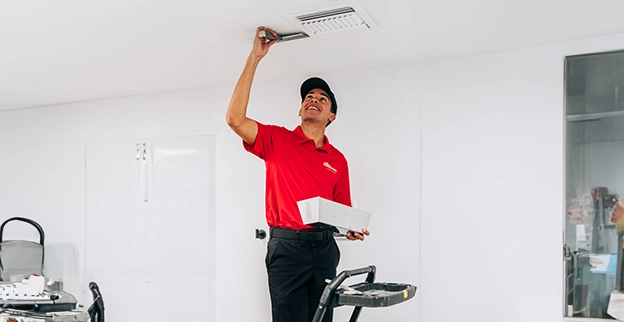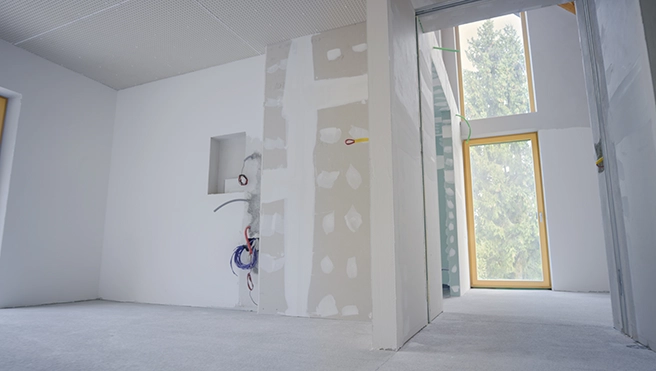If you're considering trying a DIY drywall repair in Sandy, it's important to understand that it's not simply about applying layers of joint compound. This task requires more skill and knowledge than it may seem at first, and depending on the level of damage you are attempting to fix with your patch kit, you may end up causing further damage to the entire wall if you don’t know what you’re doing.
So rather than attempt a DIY repair, homeowners who aren’t confident in their skill level should contact our skilled technicians, who can walk them through the repair and ensure a smooth finish. After all, a Sandy drywall repair is anything but a simple fix, as it features multiple steps, including but not limited to:
- Removing old drywall panels
- Repairing any subsurface damage, including wood rot
- Hiding any joints, corners, and seams with joint tape
- Applying many layers of compound
- Sanding and finishing the exterior
In addition to the repair process being complicated, it's often more cost-effective at times to get a professional drywall repair in Sandy, UT. Although you can pick up a drywall repair kit at your local hardware store, and while that may be fine for fixing small holes in your walls, it may not be sufficient for larger or more complex repairs. Professional repair services can provide a higher level of expertise and ensure a more seamless finish, ultimately saving time and effort in the long run.
During a professional Sandy drywall repair service, our skilled experts will go through a variety of different steps to ensure a flawless finish and long-lasting results. These steps will include:
- Assessment: First, they will assess the extent of the damage and determine the best approach to repair it. This will include conducting a thorough inspection of the affected areas and gathering necessary information to make informed decisions about the repair process. Additionally, they will consider factors such as time, cost, and available resources to ensure an efficient and effective repair plan. Once you approve the plan, we can move onto the actual repair work.
- Preparation: First, our carpenter will sand down any rough edges on the gypsum board's surface, using a sanding sponge to get rid of subtle debris around the damaged area. The sanding will help the joint compound adhere to it better later on, which is going to be used to plug up the damaged part.
- Plug And Chug: Now, we will apply the joint compound to the damaged surface in question using a joint knife. We will proceed with the application carefully at approximately a 90-degree angle and go layer by layer to ensure the dented spot is smoothed out. After the first application, we will check to see if the surface is level and if the dent has been filled and covered. If not, we will proceed with a second coat.
Please note: If you attempt this on your own, it's important that you remove any extra compound off the applied surface. If not, you will be susceptible to uneven surfaces, including bumps, after the drywall surface dries out.
- Set And Finish: Finally, using a sponge sander, lightly blend the area with the surrounding wallboard space until the joint compound has dried off. For a smoother appearance, you can use a damp sponge to soften out the edges.
- Just Prep: Because joint compound is porous in nature, we need to prime its surface before you paint over it. It's essential to prime the restored area, and if this is not done, the painted area will look tacky and appear different from the surrounding surface. We always recommend using a primer that matches the same paint color you are using.
- So Stylish: Finally, after the primer has dried off, we will use a softer cloth to paint over the area with wall paint, using only gentle strokes to blend in the paint with the surrounding gypsum board.
Causes of Drywall Damage in Sandy
Sheetrock is a tough material, but it's not indestructible and sooner or later will deteriorate over time as it's not completely infallible against physical imperfections. With time, it will begin to showcase hairline cracks and fractures, small holes, scuffed corners, peeling paint, loosened tape, and broken joints.
Oftentimes, the reason for a drywall repair in Sandy is not of your own doing, but due to a deeper and underlying cause, such as a broken concrete slab or soil erosion and critical damage to your house's foundation. So don't self-identify the issue before asking a professional contractor who is trained in carpentry to diagnose the problem. Thankfully, most cosmetic damages and minor blemishes for surface-level damage can be restored during a standard repair by applying a joint compound to repair a dent or nail hole or using a drywall patch to cover up a large gaping hole.
Other factors can cause damaged drywall, which may necessitate the assistance of a skilled handyman for drywall repair in Sandy, UT.
Small Holes And Leakages
If your concrete slab is rundown, it can result in a possible leakage resulting in critical damage to your home's foundation. If the slab leak were to worsen, it would continue to damage your home's foundation. Normally a slab leak is due to a leaking pipe underneath the foundation of your house. For example, if the soil surrounding the pipe expands and contracts due to erosion, it can persuade your foundation to sway or shift away from its original position. As a result, due to the exertion of excessive pressure, the burst pipe can result in a crack snaking across your wall boards and ceiling on the upper levels of the house. Until you ask a plumber to do a trenchless pipe replacement, this crack will only widen. For the time being, we can carry out a repair to disguise the unsightly blemish until you resolve the slab leak issue.
Popped Nails
A popped nail head is usually due to the contraction and expansion of the wood frame behind the gypsum board. Normally, homes are held upright with a wooden framework that is attached to the Sheetrock. As the season tide changes along the local weather conditions, your gypsum board is more susceptible to fluctuating temperatures and humidity levels. In turn, the wood framing inflates or shrinks as it adjusts to different temperatures. The wood itself becomes feeble as it loosens its grip on a nail or screws. It's best not to leave these popped nails alone; they can pose a potential safety hazard as they are a part of the drywall stud. Instead, our expert carpenter can get rid of the popped nails with a set of pliers and plug up any minor holes using a joint compound.
Furniture Scuffs
Drywall paper can easily get torn if you are lugging around big and heavy pieces of furniture. All the same, a skilled carpenter can fix the dent by sanding down the damaged area, applying a generous layer of joint compound, and painting over the area.
Termites And Rodents
Pesky pests, including termites, like to feed on paper and will make your drywall's interior a breeding ground of sorts. Plus, any fury critters, including mice and rats, also like to nestle inside your Sheetrock only to chew up your electrical wiring. Either way, both kinds of pests can create tiny holes or openings in your walls and ceilings. We suggest sealing up cracks in your wall earlier on to reduce the risk of pest invasion.
Tile Removal
If the tiles of your kitchen or bathroom backsplash have been temporarily removed for a renovation project, you may notice surface damage to your gypsum board. For example, torn paper, lingering glue adhesive, or small bits of the wall being ripped out. This physical stress can result in a crack, and depending on the extent of the damage, joint compounds need to be applied over the bruised spots and any taping over seams.
Loosened Joint Tape
Mostly, drywall taping is water-based, so if it's exposed to too much moisture, if, for example, the gypsum board gets soaking wet, it can wear away. A trained carpenter can remove the old tape, clean off the area, sand it down, and apply a fresh coat of joint compound to the Sheetrock crack.
Foundation Settling
As previously mentioned, hairline cracks or fractures in your Sheetrock highlight that it could be your home's foundation is settling. Although this is a natural process you cannot forestall, there's no need to be very concerned about a drywall crack as it doesn't necessarily mean there has been an occurrence of permanent structural damage.



